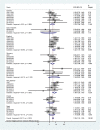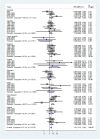A meta-analytic evaluation of sex differences in meningococcal disease incidence rates in 10 countries
- PMID: 33004098
- PMCID: PMC7592104
- DOI: 10.1017/S0950268820002356
A meta-analytic evaluation of sex differences in meningococcal disease incidence rates in 10 countries
Abstract
The magnitude and consistency of the sex differences in meningococcal disease incidence rates (IR) have not been systematically examined in different age groups, countries and time periods. We obtained national data on meningococcal disease IR by sex, age group and time period, from 10 countries. We used meta-analytic methods to combine the male to female incidence rate ratios (IRRs) by country and year for each age group. Meta-regression analysis was used to assess the contribution of age, country and time period to the variation in the IRRs. The pooled male to female IRRs (with 95% CI) for ages 0-1, 1-4, 5-9, 10-14 and 15-44, were 1.25 (1.19-1.32), 1.24 (1.20-1.29), 1.13 (1.07-1.20), 1.21 (1.13-1.29) and 1.15 (1.10-1.21), respectively. In the age groups 45-64 and over 65, the IR were lower in males with IRRs of 0.83 (0.78-0.88) and 0.64 (0.60-0.69), respectively. Sensitivity analysis and meta-regression confirmed that the results were robust. The excess meningococcal IR in young males and the higher rates in females at older ages were consistent in all countries, except the Czech Republic. While behavioural factors could explain some of the sex differences in the older age groups, the excess rates in very young males suggest that genetic and hormonal differences could be important.
Keywords: incidence rate ratios; male predominance; meningococcal disease; meta-analysis; sex differences.
Conflict of interest statement
The authors declare that they have no conflicts of interests.
Figures







Similar articles
-
Gender differences in tuberculosis incidence rates-A pooled analysis of data from seven high-income countries by age group and time period.Front Public Health. 2023 Jan 10;10:997025. doi: 10.3389/fpubh.2022.997025. eCollection 2022. Front Public Health. 2023. PMID: 36703824 Free PMC article.
-
Sex differences in campylobacteriosis incidence rates at different ages - a seven country, multi-year, meta-analysis. A potential mechanism for the infection.BMC Infect Dis. 2020 Aug 25;20(1):625. doi: 10.1186/s12879-020-05351-6. BMC Infect Dis. 2020. PMID: 32842973 Free PMC article.
-
Sex differences in hepatitis A incidence rates-a multi-year pooled-analysis based on national data from nine high-income countries.PLoS One. 2023 Jun 13;18(6):e0287008. doi: 10.1371/journal.pone.0287008. eCollection 2023. PLoS One. 2023. PMID: 37310964 Free PMC article.
-
Optimizing protection against meningococcal disease.Clin Pediatr (Phila). 2010 Jun;49(6):586-97. doi: 10.1177/0009922809354327. Epub 2010 Jan 20. Clin Pediatr (Phila). 2010. PMID: 20089551 Review.
-
Epidemiology and meningococcal serogroup distribution in the United States.Clin Pediatr (Phila). 2010 Jun;49(6):519-24. doi: 10.1177/0009922809347797. Clin Pediatr (Phila). 2010. PMID: 20507868 Review. No abstract available.
Cited by
-
Sex-Related Differences in the Immune Response to Meningococcal Vaccinations During Adolescence.Front Public Health. 2022 May 6;10:871670. doi: 10.3389/fpubh.2022.871670. eCollection 2022. Front Public Health. 2022. PMID: 35602158 Free PMC article.
-
Invasive Disease Due to Neisseria meningitidis: Surveillance and Trends in Israel Prior to and during the COVID-19 Pandemic.Microorganisms. 2023 Aug 31;11(9):2212. doi: 10.3390/microorganisms11092212. Microorganisms. 2023. PMID: 37764056 Free PMC article.
-
Gender differences in tuberculosis incidence rates-A pooled analysis of data from seven high-income countries by age group and time period.Front Public Health. 2023 Jan 10;10:997025. doi: 10.3389/fpubh.2022.997025. eCollection 2022. Front Public Health. 2023. PMID: 36703824 Free PMC article.
-
Rare fatal case of purpura fulminans due to pneumococcal sepsis in a child, associated with multiorgan failure.Germs. 2024 Jun 30;14(2):204-209. doi: 10.18683/germs.2024.1432. eCollection 2024 Jun. Germs. 2024. PMID: 39493743 Free PMC article.
-
Positive Predictive Value of Contrast-Enhanced Fluid-Attenuated Inversion Recovery (FLAIR) Magnetic Resonance Imaging in Diagnosis of Meningitis Among Pediatrics Taking Cerebrospinal Fluid Analysis as Gold Standard.Cureus. 2024 Nov 9;16(11):e73356. doi: 10.7759/cureus.73356. eCollection 2024 Nov. Cureus. 2024. PMID: 39659351 Free PMC article.
References
-
- Stephens DS, Greenwood B and Brandtzaeg P (2007) Epidemic meningitis, meningococcaemia and Neisseria meningitidis. Lancet 369, 2196–210. - PubMed
-
- Garrido-Estepa M, et al. (2014) Changes in meningococcal C epidemiology and vaccine effectiveness after vaccine introduction and schedule modification. Vaccine 32, 2604–9. - PubMed
-
- McGill F, et al. (2016) Acute bacterial meningitis in adults. Lancet 388, 3036–47. - PubMed
Publication types
MeSH terms
LinkOut - more resources
Full Text Sources
Medical

